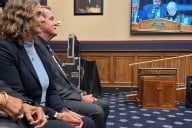You have /5 articles left.
Sign up for a free account or log in.
WASHINGTON -- With increases in state support for higher education hard to come by, some leaders of public universities are arguing that the federal government -- if not now, then eventually -- may be best suited to pick up the slack.
"State governments have proven to be unreliable partners," Robert J. Birgeneau, chancellor of the University of California at Berkeley, said here Saturday morning at the annual meeting of the American Association for the Advancement of Science. "The federal government needs to guarantee the fate of our great public institutions."
Examples abound of state disinvestment in higher education. When Gov. Rick Snyder of Michigan last week proposed cutting state support to the University of Michigan to $255 million, it meant that the state could potentially account for less than 5 percent of the total budget of its flagship institution, based on this year's expenditures.
"We're facing the prospect in which state money is so meaningless as to not be worth the regulatory burden," said James J. Duderstadt, Michigan's former president, during Saturday's panel.
While the session, which was called "The University of the Future," also considered the transformative changes being wrought by technology, globalization and demographic shifts in the student body, attention returned to the fate of public universities. Though publics educate about three-quarters of college students, increasing numbers of them are coming from outside these institutions' home states. And, paradoxically, the growing national and international stature that these flagships are assuming may be adding to the disconnect with their home states. It is arguable, said several speakers, that state legislators see some of these institutions as too globally focused, and decreasingly tied to their own soil.
Meanwhile, the economic crisis spurs the steady procession of state cutbacks, as in New York and, most dramatically, in California. The trend has already caused great worry and led many to ask to what extent public universities are, in any real sense, state institutions any longer. Some, such as Richard W. Lariviere, president of the University of Oregon (where the state supports 9 percent of the budget), recently asked for a lower -- but predictable -- stream of public subsidy with more flexibility in how to use it.
Or, as both Birgeneau and Duderstadt proposed, a more vigorous federal role. The idea is not new. Birgeneau made essentially the same argument with Frank D. Yeary, Berkeley's vice chancellor, in an op-ed in the Washington Post in 2009, in which they proposed shifting a small number of the nation's leading public research and teaching universities to a hybrid model. These institutions would receive basic operating support from federal and state governments, which could, in whole or in part, match money provided by private philanthropies to support endowed chairs.
The idea of large-scale matching grants has been tested in California, where the William and Flora Hewlett Foundation committed $110 million, to be matched by smaller grants, for 100 endowed positions at Berkeley. A model that combines private philanthropy and the government also has been realized; the University of Wisconsin at Madison announced in December that it received a $20 million matching grant from the Andrew W. Mellon Foundation and the State of Wisconsin to support the humanities. Both institutions were among the 10 top public research institutions that Birgeneau mentioned during his remarks as potentially benefiting from a larger federal role. And Wisconsin's flagship is making quiet moves to separate from the rest of the UW system.
But the idea that in the current deficit-obsessed political climate the federal government would want this responsibility may strike some as so unrealistic as to be impossible. Duderstadt worried that such an idea would be lambasted as constitutionally unjustified and as federalizing higher education.
Resistance to the idea also has been raised within academe. M. Duane Nellis, president of the University of Idaho, wrote in Inside Higher Ed that such a proposal would diminish the connection between public research and teaching universities and the economic development of their home states, and would stifle research innovation outside the few public institutions benefiting from federal largesse. On Saturday, G.P. "Bud" Peterson, president of the Georgia Institute of Technology (and a panelist), said he worried about what strings would be attached to federal money -- not that he thought it would be arriving any time soon. "I'm not holding my breath," he said.
Changes such as this begin with a vision, said Duderstadt. For example, he said, the report "Science: The Endless Frontier," produced by Vannevar Bush in 1945, laid the groundwork for what became the National Science Foundation five years later. A similar shift in attitudes could happen with higher education. "We can see this as a Vannevar Bush redux," because, he said, the U.S. lacks a true national plan for its research institutions.
A possible step to remedying that lack is under way: the National Academies has asked a committee of experts, including Duderstadt, to recommend the top 10 actions that Congress, federal and state governments and others can take to support research universities in producing research and doctoral training that enables the U.S. to compete in health, energy, the environment and national security (a similar effort was just announced for the humanities and social sciences).
Duderstadt said that other precedents exist in higher education, in which ideas that once seemed far out of the mainstream eventually came into being. The notion that the federal government should be responsible for direct lending to students took root in the early 1990s, he noted, but was not fully realized until the Obama administration pushed a restructuring of the student loan programs through in budget reconciliation legislation last year.








